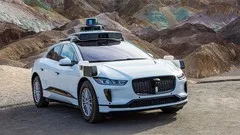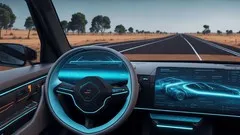
ROS2 Point Clouds For Autonomous Self Driving Car using PCL 
Get a comprehesive understanding of ROS2 Point Clouds For Autonomous Self Driving Car using PCL. This is a pay course from Udemy. AZ Class provides this course data for free. Learn more certificate and details here. Discover the fascinating world of 3D mapping and object detection with their course on ROS2 Point Clouds for Autonomous Self Driving Car using PCL. Learn how to create accurate 3D maps using RGB-D cameras and generate high-quality point clouds from your own data. Dive into the Kitti Dataset and explore lidar-based object detection techniques in real-time. Master ROS2, rviz, and PCL to create stunning visualizations and analyze your point cloud data effortlessly. Gain proficiency in implementing point cloud algorithms and segmentation techniques for computer vision applications. Unlock the ability to process real-world 3D Lidar data for autonomous vehicles and robotics. Get started today and unleash your potential in this exciting field. ▼
ADVERTISEMENT
Course Feature
![]() Cost:
Cost:
Paid
![]() Provider:
Provider:
Udemy
![]() Certificate:
Certificate:
Paid Certification
![]() Language:
Language:
English
![]() Start Date:
Start Date:
2023-05-31
Course Overview
❗The content presented here is sourced directly from Udemy platform. For comprehensive course details, including enrollment information, simply click on the 'Go to class' link on our website.
Updated in [October 07th, 2023]
What does this course tell?
(Please note that the following overview content is from the original platform)
Welcome to our course on Point Clouds! In this course we will explore the exciting world of 3D mapping and object detection using point cloudsWe will start with RTAB mapping a powerful technique for creating accurate 3D maps using RGB-D cameras Through hands-on projects you will learn how to use this technique to generate high-quality point clouds from your own dataNext we will dive into the Kitti Dataset and explore how to use 3D lidars for object detection We will teach you how to use advanced techniques for detecting objects in real-time such as lidar-based segmentation and clusteringWe will also cover ROS2 an essential tool for visualizing and processing point cloud data With ROS2 you will learn how to use rviz and PCL to create stunning visualizations and analyze your point cloud data with easeIn addition we will explore cylindrical and planar segmentation two important techniques for extracting meaningful information from your point cloud data Through a series of hands-on exercises you will learn how to use these techniques to accurately identify and classify objects in your point cloudsSections :Basic Data Understanding in CPPPoint cloud Algorithms and SegmentationReal World 3D Lidar Processing ( Up - coming )Outcomes After this Course : You can create 1 Understanding of basic data structures and algorithms in CPP programming language which is essential for implementing computer vision and machine learning applications2 Proficiency in implementing point cloud algorithms and segmentation techniques that are commonly used in computer vision applications such as object recognition scene reconstruction and robotics3 Ability to process real-world 3D Lidar data which is essential for autonomous vehicle applications and other robotics applications that involve sensing and perceptionSoftware Requirements UBUNTU 2204 LTSROS2 HumbleBasics of C++- Before buying take a look into this course GitHub repository
We considered the value of this course from many aspects, and finally summarized it for you from two aspects: skills and knowledge, and the people who benefit from it:
(Please note that our content is optimized through artificial intelligence tools and carefully reviewed by our editorial staff.)
What skills and knowledge will you acquire during this course?
During this course on ROS2 Point Clouds for Autonomous Self Driving Car using PCL, the learner will acquire the following skills and knowledge:
1. Understanding of basic data structures and algorithms in CPP programming language: The course will provide a foundation in CPP programming language, which is essential for implementing computer vision and machine learning applications.
2. Proficiency in implementing point cloud algorithms and segmentation techniques: The learner will gain hands-on experience in using point cloud algorithms and segmentation techniques commonly used in computer vision applications, such as object recognition, scene reconstruction, and robotics.
3. Ability to process real-world 3D Lidar data: The course will teach the learner how to process real-world 3D Lidar data, which is crucial for autonomous vehicle applications and other robotics applications that involve sensing and perception.
4. Knowledge of RTAB mapping: The learner will learn about RTAB mapping, a powerful technique for creating accurate 3D maps using RGB-D cameras. They will be able to generate high-quality point clouds from their own data using this technique.
5. Understanding of the Kitti Dataset: The course will explore the Kitti Dataset and teach the learner how to use 3D lidars for object detection. They will learn advanced techniques such as lidar-based segmentation and clustering for real-time object detection.
6. Familiarity with ROS2: The course will cover ROS2, an essential tool for visualizing and processing point cloud data. The learner will gain knowledge on how to use rviz and PCL to create stunning visualizations and analyze point cloud data with ease.
7. Knowledge of cylindrical and planar segmentation: The course will explore cylindrical and planar segmentation techniques, which are important for extracting meaningful information from point cloud data. The learner will learn how to accurately identify and classify objects in point clouds using these techniques.
Who will benefit from this course?
This course on ROS2 Point Clouds for Autonomous Self Driving Car using PCL will benefit individuals and professionals in the following fields:
1. Computer Vision and Machine Learning: This course provides a solid understanding of basic data structures and algorithms in CPP programming language, which are essential for implementing computer vision and machine learning applications. Participants will gain proficiency in implementing point cloud algorithms and segmentation techniques commonly used in computer vision applications such as object recognition, scene reconstruction, and robotics.
2. Autonomous Vehicle Engineers: The ability to process real-world 3D Lidar data is crucial for autonomous vehicle applications. This course equips participants with the skills to process and analyze 3D Lidar data, which is essential for autonomous vehicle navigation, obstacle detection, and perception.
3. Robotics Engineers: Robotics applications often involve sensing and perception, and point cloud data plays a significant role in these tasks. This course provides the knowledge and techniques required to work with point cloud data, enabling robotics engineers to extract meaningful information, identify and classify objects, and perform scene analysis.
4. Researchers and Academics: Researchers and academics in the fields of computer vision, robotics, and autonomous systems can benefit from this course by gaining practical knowledge and skills in point cloud processing. The course covers advanced techniques such as lidar-based segmentation and clustering, which can be applied in research projects and academic studies.
5. Software Developers: This course requires a basic understanding of C++ programming language. Software developers interested in expanding their skills in computer vision, robotics, and autonomous systems can benefit from this course by learning how to implement point cloud algorithms and segmentation techniques using PCL and ROS2.
Course Syllabus
Basic Point Cloud Data Understanding
Point cloud Algorithms and Segmentation
3D Lidar Point Clouds of Kitti Dataset
Course Provider

Provider Udemy's Stats at AZClass
Discussion and Reviews
0.0 (Based on 0 reviews)
Explore Similar Online Courses

POSTMAN API Testing - Step by Step for Beginners

Autonomous Vehicles: A Complete Guide on Driverless Cars

Python for Informatics: Exploring Information

Social Network Analysis

Introduction to Systematic Review and Meta-Analysis

The Analytics Edge

DCO042 - Python For Informatics

Causal Diagrams: Draw Your Assumptions Before Your Conclusions

Whole genome sequencing of bacterial genomes - tools and applications

Self Driving and ROS - Learn by Doing! Odometry & Control

Autonomous Cars Drones & Electric Mobility - Top Track 2021


Start your review of ROS2 Point Clouds For Autonomous Self Driving Car using PCL